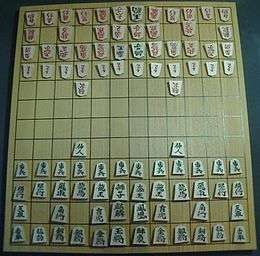Space shogi
Space shogi is a three-dimensional shogi variant invented by George R. Dekle Sr. in 1987.[1][2] The gamespace comprises nine 9×9 shogi boards stacked vertically. Each player controls a standard set of shogi pieces.
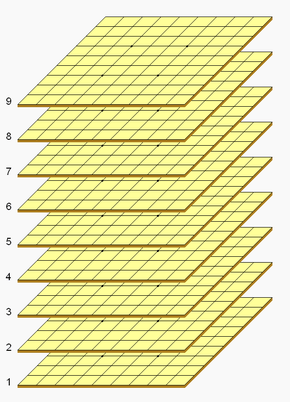
Space Shogi 3D gamespace
Space shogi was included in World Game Review No. 10 edited by Michael Keller.[3]
Game rules
Space shogi follows standard shogi conventions, including the same types and numbers of pieces, and a similar initial setup. All the normal shogi rules apply, including drops, promotion, check, checkmate, and impasse. But pieces have the freedom of three-dimensional movement.
Starting setup
Black starts the game occupying levels 1 through 3; White starts on levels 9 through 7.
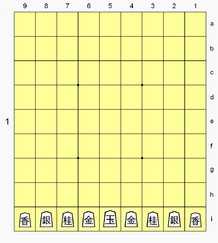
Black's level 1 (and White's level 9, rank a) starting setup. Unlike standard shogi, the silver is placed between the lance and the knight (8i and 2i in the diagram).
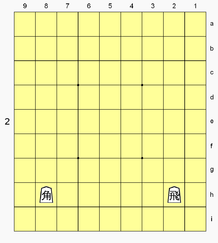
Black's level 2 (and White's level 8, rank b) starting setup. The bishop and rook occupy the same positions as in standard shogi.
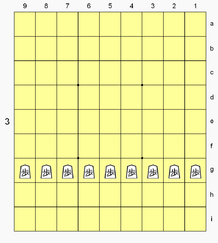
Black's level 3 (and White's level 7, rank c) starting setup. The pawns fill the same rank as in standard shogi.
gollark: Yes.
gollark: It can probably be modified to hold a mapping from (recent) message IDs of things it bridges to original message IDs.
gollark: Odd.
gollark: Well, I used tcpdump, and it looks like it sees the connections but ignores them?
gollark: So I disagree.
See also
- Three-dimensional chess
- Also by George Dekle:
- Hexshogi — a variant with hexagonal cells
- Trishogi — a variant with triangular cells
- Masonic shogi — a variant with standard cells but staggered ranks
References
- Pritchard (1994), p. 285
- Pritchard (2007), p. 261
- Keller, Michael, ed. (June 1991). "A Panorama of Chess Variants". World Game Review. No. 10. Michael Keller. ISSN 1041-0546.
Bibliography
- Pritchard, D. B. (1994). The Encyclopedia of Chess Variants. Games & Puzzles Publications. ISBN 0-9524142-0-1.CS1 maint: ref=harv (link)
- Pritchard, D. B. (2007). Beasley, John (ed.). The Classified Encyclopedia of Chess Variants. John Beasley. ISBN 978-0-9555168-0-1.CS1 maint: ref=harv (link)
This article is issued from Wikipedia. The text is licensed under Creative Commons - Attribution - Sharealike. Additional terms may apply for the media files.
